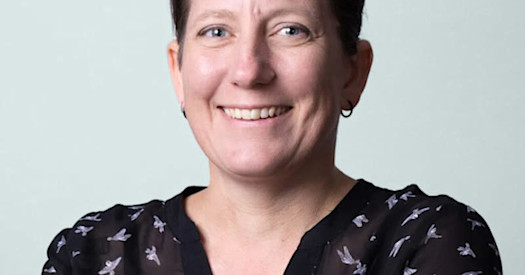 Ivan Woo, an undergraduate research assistant, works alongside Silvia Casadei, PhD, the human genetics lead at the Brotman Baty Institute.
Ivan Woo, an undergraduate research assistant, works alongside Silvia Casadei, PhD, the human genetics lead at the Brotman Baty Institute.
By: Matt Fitzsimons, UW Medicine
Over the past 30 years, genetic sequencing has revealed the human genome is 99.9% identical from one person to the next. The problem is you could fill a book with everything we don’t know about the other 0.1%. And so, page by page, a team of UW researchers is helping to do just that.
That book is called the Atlas of Variant Effects, and researchers say it will eventually include maps for all known variations of human DNA, hundreds of millions of them. These tiny differences are what make each of us unique. Some variants, however, are also associated with disease. Knowing how different variants affect people — and which ones have no effect — can accelerate diagnoses and guide the design of treatments.
An international team led by UW Medicine faculty at the Brotman Baty Institute expects to map 1,000 genes by 2030, representing a massive leap forward from current understanding.
“We have about 50 done, so we have 950 more to go, and that’s not just here at UW Medicine, that’s around the world,” says Douglas Fowler, PhD, a professor of genome sciences, adjunct professor of bioengineering, as well as co-director of the UW Center for the Multiplexed Assessment of Phenotype (CMAP). “A thousand genes would give us functional data for about 80% of the U.S. Those variants that we can’t figure out what they do? We’d have data for about 80% of them.”
Charting Unknowns
Today, most variants are a mystery. Variants of uncertain significance, they are called. The UFOs of genetics. The lack of information about them is frustrating for providers like Jill Johnsen, MD, professor in the Department of Hematology and Oncology at the UW School of Medicine and a collaborator in the Atlas of Variant Effects project. Johnsen points to hemophilia as an example of why this work matters so much. While it’s a rare disease, it is also well studied. Yet, researchers still don’t understand many of the genetic drivers.
“I think that really illustrates the scale of the problem because here’s a disorder we’ve known about for years,” Johnsen says. “We’ve known about the gene since the ’80s. We’ve been sequencing this gene over and over, and even with that, we don’t have enough evidence to always say with confidence what variants are causing disease.”
Collaborative Effort
Established in November 2017 with a philanthropic gift from Jeff and Susan Brotman and Dan and Pam Baty, the Brotman Baty Institute was created by UW Medicine, Fred Hutch Cancer Center and Seattle Children’s to take advantage of Seattle’s rich research ecosystem to accelerate biomedical discoveries and improve patient outcomes.
“We’re reaching across the world to bring people together,” says Lara Muffley, the director of program operations for the Atlas of Variant Effects Alliance, which includes more than 700 collaborators from 50 countries. “It’s remarkable, not only to have the vision for this but to also make it happen. I think the collaboration we are seeing is unique, and the results are amazing.”
New Capabilities
The community-building efforts have coincided with technological breakthroughs, further accelerating the pace of discovery. A growing suite of tests, collectively known as multiplexed assays of variant effect, can now characterize massive numbers of variants simultaneously.
“Multiplexed assays enable us to measure 10,000 variants at once,” Fowler says. “And 10,000 is kind of a magic number because that’s the number of single-letter variants in a typical gene. If you can measure 10,000 variants at a time you can basically measure all the variants that could happen in a gene.”
That rate of analysis puts researchers on track to reach their target of mapping 1,000 genes by 2030. Their work encompasses genetic disorders that are so rare, they don’t attract funding from pharmaceutical companies because the return would be relatively small compared with the investment. Meanwhile, the institute’s research is already paying dividends to patients and their families.
“There was a new baby coming, and we needed something that informed the care of the baby,” Johnsen says. “Within a couple hours, we were able to go into the map and pull out that score and reinterpret the variant, which was a big deal to the team that was taking care of that baby.”
Along with Fowler, Lea Starita, PhD, co-leads the institute’s work on variants of uncertain significance.
“Knowing which variants lead to increased risks of disease is essential to the practice of precision medicine,” says Starita, who also serves as co-director of the Brotman Baty Advanced Technology Lab. “Increasingly, genomic information will influence healthcare decisions that, in turn, will enable healthier futures for all people regardless of race, gender or ethnicity.”


